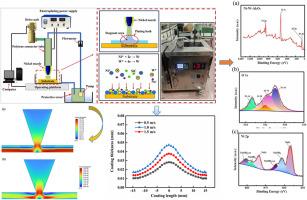Preparation and characterization of jet electrodeposited Ni-W-Al2O3 coatings
IF 3.4
4区 化学
Q2 CHEMISTRY, MULTIDISCIPLINARY
引用次数: 0
Abstract
This study investigates the influence of fluid flow rates (Vi) on the performance of Ni-W-Al2O3 coatings. The coatings were deposited via jet electrodeposition with varying Vi to assess their impact on coating properties. Scanning electron microscopy (SEM), X-ray diffraction (XRD), X-ray photoelectron spectroscopy (XPS), microhardness testing, and wear resistance evaluations were employed to characterize the microstructure, composition, hardness, and wear resistance of the coatings. The results showed that the coating deposited at 1.0 m/s exhibited a uniform, compact, and fine microstructure. The thicknesses of the three coatings were 28.1 μm, 46.5 μm, and 37.4 μm, respectively. The sample deposited at 1.0 m/s displayed the lowest intensity of the Ni-W diffraction peak. XPS analysis revealed a complex chemical composition, including both metallic and oxidized forms of nickel, tungsten, and aluminum, along with various oxygen species. At 1.0 m/s, the Ni-W-Al2O3 coating achieved a microhardness of 725.4 HV, the highest among the four coatings and approximately 61.4 % greater than that of the Ni-W coating. The friction coefficient and wear loss for this sample were 0.46 and 15.7 mg, respectively. It exhibited the smallest wear scar, approximately 13.5 μm and about one-fifth that of Q235 steel demonstrating excellent wear resistance. Electrochemical testing further confirmed that the coating deposited at 1.0 m/s exhibited the highest corrosion resistance, characterized by the most positive corrosion potential (−0.104 V), the lowest corrosion current density (7.582 × 10−7 A cm−2), and the highest polarization resistance (8167.0 Ω cm2), indicating improved protective performance in corrosive environments.

射流电沉积Ni-W-Al2O3涂层的制备与表征
研究了流体流速(Vi)对Ni-W-Al2O3涂层性能的影响。采用射流电沉积的方法沉积不同Vi的涂层,以评估其对涂层性能的影响。采用扫描电镜(SEM)、x射线衍射(XRD)、x射线光电子能谱(XPS)、显微硬度测试和耐磨性评价对涂层的微观结构、成分、硬度和耐磨性进行了表征。结果表明,在1.0 m/s速度下沉积的涂层具有均匀致密、微观组织精细的特点。涂层厚度分别为28.1 μm、46.5 μm和37.4 μm。以1.0 m/s速度沉积的样品的Ni-W衍射峰强度最低。XPS分析揭示了其复杂的化学成分,包括金属和氧化形式的镍、钨和铝,以及各种氧。在1.0 m/s速度下,Ni-W- al2o3涂层的显微硬度达到725.4 HV,比Ni-W涂层高约61.4%。该样品的摩擦系数和磨损损失分别为0.46和15.7 mg。其磨损痕最小,约为13.5 μm,约为Q235钢的五分之一,具有良好的耐磨性。电化学测试进一步证实,在1.0 m/s下沉积的涂层具有最高的耐蚀性,其腐蚀电位最高(- 0.104 V),腐蚀电流密度最低(7.582 × 10−7 A cm−2),极化电阻最高(8167.0 Ω cm2),表明涂层在腐蚀环境中的防护性能有所提高。
本文章由计算机程序翻译,如有差异,请以英文原文为准。
求助全文
约1分钟内获得全文
求助全文
来源期刊
CiteScore
3.50
自引率
7.70%
发文量
492
审稿时长
3-8 weeks
期刊介绍:
The Journal of the Indian Chemical Society publishes original, fundamental, theorical, experimental research work of highest quality in all areas of chemistry, biochemistry, medicinal chemistry, electrochemistry, agrochemistry, chemical engineering and technology, food chemistry, environmental chemistry, etc.

 求助内容:
求助内容: 应助结果提醒方式:
应助结果提醒方式:


